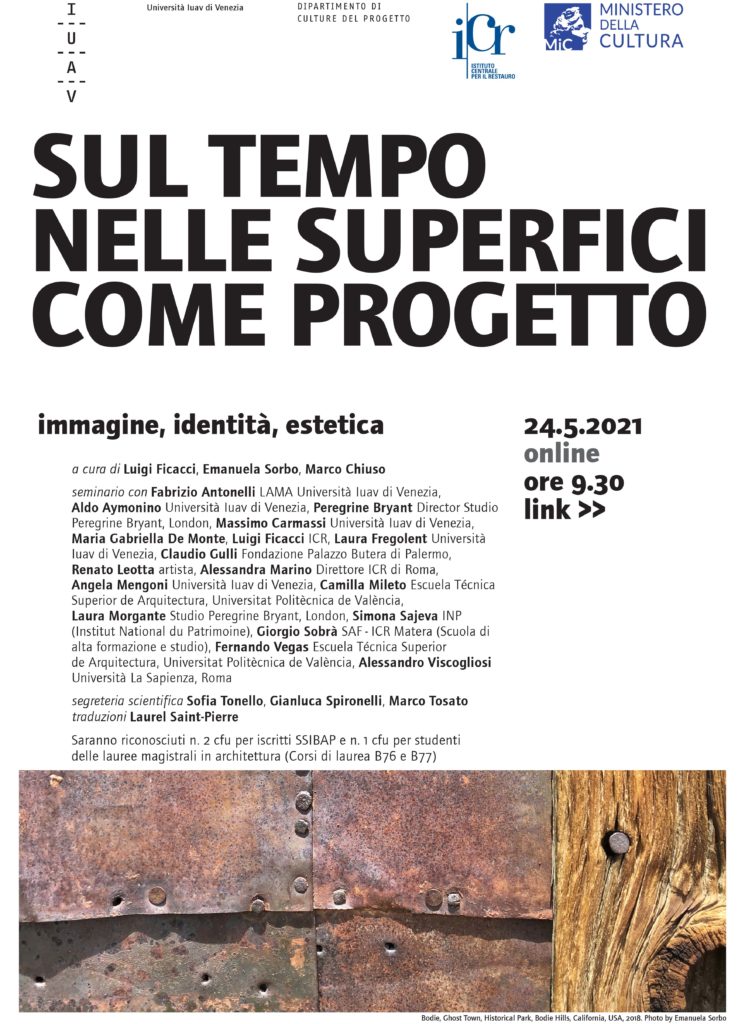
Seminar IUAV/ICR

Intervento di Simona Sajeva
(English below..)
TITOLO
Il “momento” del restauro delle superfici dell’architettura e i degradi di origine meccanica come indicatori temporali: della storia passata, dello stato di conservazione presente e dell’evoluzione futura.
Un contributo di metodo alle fasi di conoscenza, progetto ed intervento
ABSTRACT
Le superfici decorate dell’architettura riportano molteplici segni rivelatori della loro storia e del loro stato di conservazione. Dalla loro lettura dipende la comprensione dei fenomeni che li hanno originati.
Alcune chiavi di lettura sono parte della pratica ordinaria e condivisa. Altre meno, come l’analisi dei degradi di origine meccanica, ovvero quei segni imputabili alle strutture di supporto. Ciò si deve in larga parte all’approccio compartimentato tra beni architettonici e artistici, che tra i vari effetti ha prodotto l’esclusione dell’edificio, del suo comportamento strutturale, dalla conservazione delle superfici, ad eccezione di alcune tematiche e circostanze.
I degradi di origine meccanica presenti sulle superfici sono chiavi di accesso alla storia passata, allo stato di conservazione al momento dell’analisi ed anche alla probabile evoluzione futura. Per far ciò però bisogna guardare alle superfici dell’architettura come parti di un insieme organico, l’edificio. Se in astratto l’esercizio può apparire semplice, nella pratica non lo è. Le barriere sono tante: le scale di osservazione, le competenze, i linguaggi, i momenti di intervento e le procedure.
Con l’ausilio di casi concreti, questo contributo intende illustrare come, attraverso l’analisi dei degradi di origine meccanica, lo studio delle strutture può essere integrato in quello delle superfici, aumentando la consapevolezza dei fenomeni passati e nel medio-lungo periodo, con un importante contributo alla progettazione degli interventi conservativi, sia preventivi, curativi che di restauro.
TITLE
The “moment” of architectural surface conservation and mechanistic deterioration as temporal indicator: of past history, current state of conservation and future development. An essay on method in the phases of recognition, project and intervention
ABSTRACT
Decorative surfaces in architecture contain multiple revelatory signs of their history and state of conservation.
Some keys to reading them are part of normal and shared practices. Others are less so, such as the analysis of mechanistic degradation, or signs attributable to the support structure. This is in large part due to the compartmentalized approach to architectural and artistic monuments, which, among various consequences, has resulted in the exclusion of the building and its structural behaviour from the conservation of its surfaces, with the exception of a few cases and circumstances.
Instances of mechanistic deterioration present on surfaces are key to accessing past history, the state of conservation at the moment of analysis and also probable future development. To read them, however, it is necessary to consider architectural surfaces as part of the building as an organic whole. If, in the abstract, this may seem straightforward, in practice, it is not. There are many obstacles: the scale of the analysis, the expertise, the languages, the timing of the intervention and procedures.
Making use of actual cases, this presentation aims to illustrate, through the analysis of mechanistic deterioration, how the study of structures may be integrated into the study of surfaces, increasing our knowledge of past phenomena in the mid-to-long-term period, and significantly contributing to the planning of conservation interventions, whether they be for prevention, rehabilitation or restoration.
 INTERFACES Engineering applied to Conservation
INTERFACES Engineering applied to Conservation